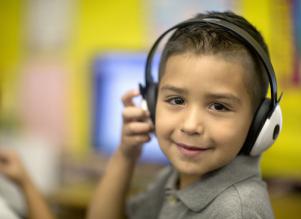1/1/2019
5 Ways Edtech Helps Educators Target Early Reading Skills
You may have heard that third grade is a key time for shifting from “learning to read” to “reading to learn.” That’s because it's the major transitional point at which information in academic textbooks used in school often becomes more complex than everyday conversational speech.
Students who are reading proficiently by the end of third grade are four times more likely to graduate high school than their peers reading below grade level. If a student is reading below grade level at the end of third grade and also lives in a household that falls below the federal poverty line, that student is six times more likely than their peers to not graduate high school (Hernandez, 2012).
Preparing for the critical third grade shift is also key for the more than 10 percent of students in the United States who are English Learners (ELs) (NCES, 2017). In fact, on the National Assessment of Educational Progress, 32 percent of ELs scored at a basic level or above (i.e., reaching proficiency or proficient) compared to 72 percent of non-ELs.
Although high-quality reading instruction is essential for every student to prepare to “read to learn” by third grade, it is especially crucial for students also learning to read and write in English. Quality reading instruction including explicit, targeted direction and practice in areas such as phonological awareness, phonics skills, vocabulary, oral language fluency, and comprehension is effective for all students, including students learning English. However, as classrooms grow and needs of students within the same classroom can vary widely, it becomes increasingly difficult to provide explicit, targeted instruction for every student for every reading skill. That said, technology-based supplements to reading instruction can provide teachers with tools to differentiate the teaching of these early literacy skills well before students reach third grade.
Here are 5 examples of how technology could be used to support both the teacher and the student in building foundational reading skills in the early grades.
1. Filling in gaps
Students enter school with varying degrees of pre-exposure to reading activities in both their native language (if learning English) and English. For instance, a student might be a strong speaker (oral language) but doesn’t fully understand the meaning all the words they are using (vocabulary). In such cases, a technology-based approach can be used to target skill gaps that are personalized to each student. Additionally, information presented digitally can be shown over and over, even if only one student in the classroom needs practice with a particular skill or set of vocabulary words. Using a technology tool for individualized instruction also comes in handy when a student may be in second grade but has kindergarten-level vocabulary knowledge, as the tech tool can aid teachers in instructing reading skills from outside their current grade-level of expertise.
2. Removing time constraints
While working one-on-one to target each child's individual skill development needs can be a challenge within the time limits of the school day, technology tools allow for each student to independently work on the skills they need all at the same time. Moreover, digital tools can produce actionable data for teachers that may translate into time savings. For example, pinpointing specific areas in which students need extra practice can help teachers better plan their time for whole-class and small-group lessons by taking into account the specific needs of their classrooms.
3. Oral reading practice
Reading aloud can sometimes be nerve-wracking for students, especially those who may not be reading at the same level as their peers. Despite these fears, it is important to practice reading aloud to develop oral reading fluency. When students have the opportunity to read and vocalize words, sentences, and stories into their computer or tablet’s microphone with recording enabled, teachers can listen later to evaluate areas where extra practice or instruction is needed. Students will also be able to keep the recordings, which will allow them to track how they’ve improved over time, and they may listen to their recordings to gain more comfort and confidence in their own oral reading abilities.
4. Listening comprehension practice
To practice listening comprehension in a new and less routine way, students can listen to and interact with familiar songs and illustrated audiobooks on tablets or laptops. Where possible, culturally relevant music and stories can be integrated to provide additional context. Older students could be asked to write a short summary of the story’s main plot points while younger students could retell the story (also practicing oral reading skills) to a peer or teacher. All students can be instructed to flag unfamiliar words or phrases and then turn the words into vocabulary flashcards, and illustrations and animations can be used as visual context clues for unfamiliar words.
5. Filling reading gaps with quality instruction
Quality reading instruction that consists of explicit teaching of foundational literacy skills is essential to ensuring students read fluently at grade level by third grade. As students begin each school year with varying reading skill profiles, it is important to fill in reading skill gaps; that said, it is sometimes difficult to 1) know which gaps exist and 2) provide individualized instruction for each student's specific needs. Technology-based tools can be used in fun and time-saving ways to close reading skill gaps for students from a variety of reading backgrounds and skill profiles before they reach the critical third-grade transition.
WHAT DO YOU THINK?
These are only 5 ways that educational technology can help educators target early reading skills. Does your school or district use an edtech program that targets oral language and listening skills? What results have you seen? Connect with Lexia Learning on Twitter, Facebook, and LinkedIn and let us know your thoughts and experiences on this topic.


